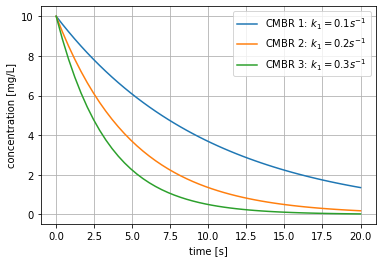First order kinetics in CMBR
Notes on course in Environmenal Engineering
Problem statement
Lets consider 3 continously mixed batch reactors (CMBR) with first-order decay kintetics (\(k_1\)) for a substance with initial concentration \(C_0\).
The parameters for each reactor are listed below:
- CMBR 1: C\(_0\) = 10 mg/L , \(k_1\) = 0.1 s\(^{-1}\)
- CMBR 2: C\(_0\) = 10 mg/L , \(k_1\) = 0.2 s\(^{-1}\)
- CMBR 3: C\(_0\) = 10 mg/L , \(k_1\) = 0.5 s\(^{-1}\)
- Plot the concentration of each reactor as a function of time.
- ¿What is the concentration of the substance in each reactor after 10 sec?
Solution
The concentration of a susbstance in a CMBR that decays with first order kinetics can be modeled as follows:
\[ C(t) = C_o e^{-k_1t} \tag{1}\]
Lets implement this equation numerically through a function:
Note that our function receives the initial concentration C0, the first-order decay rate k1, and the time. Therefore, we can use the same function to model the 3 CMBRs.
Plot of concentration
time = linspace(0, 20) # time in sec
k1 = [0.1, 0.2, 0.3] # fist-order decay kinetics (1/s)
C0 = [ 10, 10, 10] # initial concentrations (mg/L)
for i, k in enumerate(k1):
Ct = conc(C0[i], k, time)
plt.plot(time, Ct, label="CMBR %i: $k_1 = %s s^{-1}$" % (i+1, k) )
plt.xlabel("time [s]")
plt.ylabel("concentration [mg/L]")
plt.legend()
plt.grid()
plt.show()
Concentration of substance after 10 sec
We can use our function considering 10 sec as the input time to ompute the concentration of the substance.
Follow up questions
- How much time is required for the concentration to be zero in each reactor?
- Calculate the time it takes for each reactor to reach half of the initial concentration (\(t_{1/2})\).